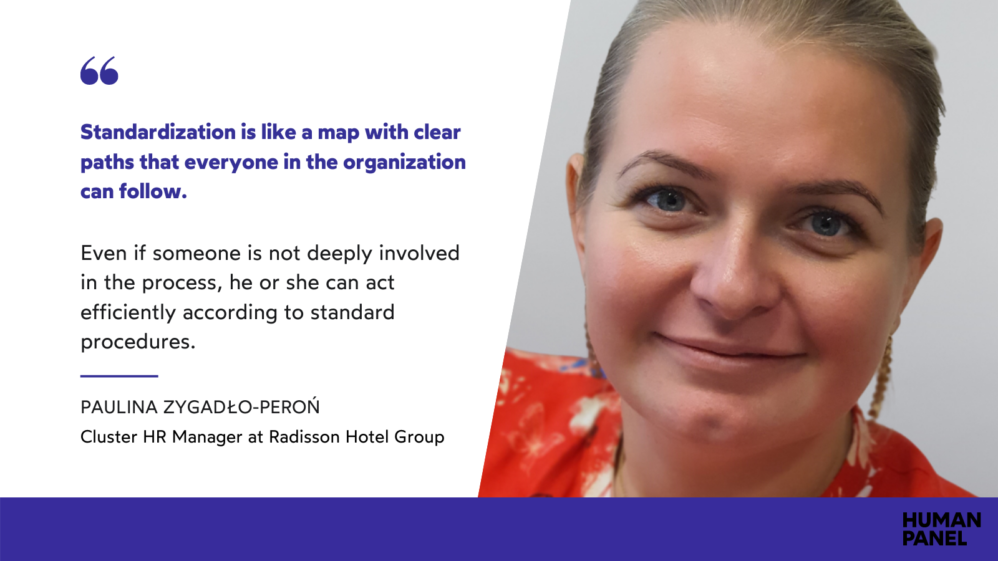Radisson’s 7 steps to successful recruitment

We talk to Paulina Zygadło-Peroń, Cluster HR Manager at Radisson, about the ingredients of a successful recruitment process.
Paulina Zygadło-Peroń is an HR manager with over 12 years of experience. Today, she works as Cluster HR Manager at Radisson Hotel Group Poland, where she is responsible for recruitment and talent acquisition processes.
Radisson is one of the world’s largest hotel groups with nine distinct hotel brands, and more than 1,400 hotels in operation and under development in 120 countries, including Poland.
Paulina shared with us 7 steps she finds necessary for effective recruitment.
1. Standardization
I find standardization the key to creating an effective operational framework within the organization. The larger the company, the more important it is to speak with one voice and stick to procedures, as it streamlines processes and eliminates unnecessary elements, leading to greater time efficiency.
Standardization not only helps recruiters – it helps applicants, too. Both sides feel more confident when they know the timeline and stages of the process.
I would compare it to a map with clear paths that everyone in the organization can follow. Even if someone is not deeply involved in the process, he or she can act efficiently according to standard procedures.
2. Automation
Automation is tightly linked to standardization. Good workflows allow us to automate much of the process. For example, using job posting templates or email templates that are created automatically allows recruiters to save time and adhere to standards. In addition, automation allows us to correlate different processes and extract valuable data from them.
I believe that at a certain point in a company’s lifecycle, both standardization and automation are a must. They are our guideposts that we use to safely achieve our goals.

3. Tracking the right HR metrics
There are dozens of HR recruitment metrics, and having a dashboard that collects them all in one place is very useful. However, I would say that we should prioritize and monitor those metrics that are critical to us.
For me, the most important HR hiring metrics are: source of hire, cost per hire, and time to hire. What I want to track more closely is hiring manager satisfaction and candidate experience, which I’ll go into in more detail in the next point.
4. Measuring the candidate experience
Recruiting has long been a challenging and competitive field. Talent acquisition and retention are at the top of most companies’ lists, which means you have to track candidate experience.
This is not easy to measure, as the perspective of the recruiting process changes once a candidate is successfully hired. On the other hand, the response rate is low for candidates who resign or were rejected during the process. Some share their thoughts on social media, but this data can be very unreliable.
As a recruiter, I’d also like to see the candidate’s perspective: are my job descriptions accurate? Is there an area we could improve? Does the language reflect our company values?
Standardization helps ensure that applicants have a positive experience, but my number one rule is: treat the applicant the way you would want to be treated.
5. Avoiding popular mistakes
Mistakes happen to everyone. That said, it will be quite easy to avoid making some of the most popular ones:
Not giving feedback
It is highly advisable to give the candidate feedback at every step of the process, irrespective of what the outcome of the process is. Leaving people without a response is probably one of the most frequently occurring recruitment mistakes. Not only does it affect the candidate’s experience, but it can also turn them off of the product or service a company offers.
Inadequate job description
Beware of vague and very general job descriptions, as they lead to inefficient recruiting, unsuitable candidates, and wasted time. I recommend carefully profiling job descriptions and creating them with the hiring manager to establish clear expectations and duties: What is a must-have and what is a nice-to-have? This saves a lot of time and hassle and leads to better hires.
Mismatched recruitment tactic
Remember that not all jobs require a multi-step hiring process, case studies, trial days, or assessment centers. You should tailor the process to the job and use appropriate tools to test the candidate.
Lack of dialogue
The interview is not only to test and vet the candidate, but also to give them the opportunity to ask questions about the role, company culture and future responsibilities.
Follow us on Twitter for more insights!
6. The right tools
I cannot imagine recruitment without today’s data collection and processing tools. The statistics provided by integrated platforms and systems are a goldmine for any recruiter. Even if you are not using advanced tools, you can pull a lot of information from job board vendors and gather other valuable data points.
Another important area where tools play a role is communication. Anything that allows for better candidate contact will improve your recruiting process.
7. Following your core values and beliefs
The years I have spent recruiting have taught me that the fit of the candidate to the company is one of the most important factors in a successful hire. During interviews, we carefully consider the candidate’s fit with our core values and beliefs. We also emphasize these values already in the job offers and follow them throughout the recruitment process.
My recipe for success is simple: share your company’s values and hire talent that shares those values as well. At Radisson, we believe that most things can be learned – the key is to find the right personality and character.
Do you want to see the business impact of your HR initiatives? Would you like to know if your actions bring measurable results? Check out our free demo and see how Human Panel can improve your recruitment process, plan career paths and increase diversity. Contact us by filling in the short form below.




